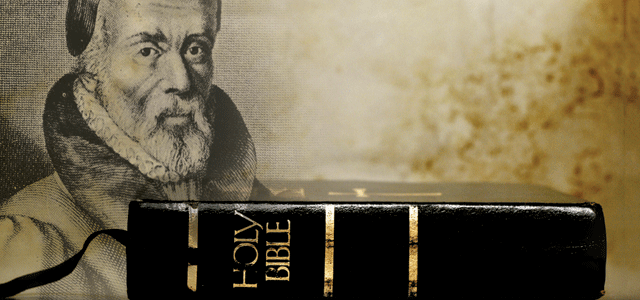The Bible in Our Own Language
May 1, 2013

Glenn Townend recalls the story of one of his ancestors, who was especially responsible for translating the Bible into English.
Five hundred years ago, the average person’s ignorance of the Bible stemmed from the fact that all holy books were written in Latin, Greek or Hebrew—languages of the scholarly elite. It was at this time that one of my forebears became instrumental in changing society.
A Man To Change The World
William Tyndale was born into a well-to-do Catholic family in Gloucestershire, England, around 1493. In 1506, he was sent off to study at Oxford. Some 10 years later, he received a master of arts degree in theology and was ordained a priest.
In 1519, Tyndale went to Cambridge, where he was introduced to the “new learning” of the Renaissance. He began to realise that the established church determined what the common people believed by keeping the Bible in little-known foreign languages, thus forbidding them access to its teachings. In this way, the church maintained a grip on people’s souls and so determined their obedience and loyalty.
Tyndale observed that “it was impossible to stablish the lay people in any truth, except the Scriptures were plainly laid before their eyes in their mother tongue.” While debating with another clergyman, he promised, “If God spares my life, ere many years, I will cause the boy that driveth the plow to know more of the Scriptures than thou dost!”
Tyndale left Cambridge in 1521 and went to tutor in the household of Sir John Walsh in Gloucestershire. His desire to make the Bible accessible to the common people led him to openly challenge church leaders, who eventually labelled him a heretic.
In 1523, Tyndale started devoting his time completely to translating the Bible into English. Humphrey Monmouth, a wealthy London cloth merchant and a member of the Merchant Adventurers who traded with Europe, supported Tyndale financially.
For the Common People
The next year, Tyndale moved to Wittenburg, Germany, where it was safer and easier to find a printer who would publish his soon-to-be-completed English Bible. While there, he enrolled in the university where Martin Luther was teaching. He continued to work at translating the New Testament into English from its Greek and Latin sources.
In March 1526, he had an English New Testament published. Thousands of copies were smuggled into England. One German scholar observed that “the English . . . were so eager for the gospel . . . that they would buy the New Testament even if they had to give a hundred thousand pieces of money for it.” Fortunately, Tyndale’s merchant friends kept the price low, so even lower income earners could afford it.
Tyndale’s New Testament translation caught the attention of Bishop Tonstall in London, who declared it against the teachings and authority of the church, and ordered that all copies be seized and publicly burned. In an attempt to prevent its sale, Tonstall purchased all the copies he could locate, which was most of them. While this outraged the people, the income gave Tyndale and his merchant friends the immediate means to print more Bibles!
Man In Hiding
Little is known of Tyndale’s whereabouts while he was a fugitive in Europe. However, by 1529, he had mastered Hebrew and by 1530, he had translated the first five books of the Old Testament (commonly called the Pentateuch) into English. Terms such as passover, scapegoat, tender mercies, longsuffering and birthright, which are still used today, were coined by Tyndale.
In 1530, Tyndale wrote “The Practyse of Prelates,” opposing King Henry VIII’s planned divorce from Catherine of Aragon and marriage to Anne Boleyn on the grounds that it was not scriptural. This treatise now made him an enemy of the king of England as well as of the church.
Once again, Tyndale went into hiding, resurfacing in Antwerp in 1534. His merchant friends continued to give him a stipend, much of which he gave to the English who were fleeing religious persecution in England. His revised New Testament was printed that same year.
In 1535, Tyndale met and befriended Henry Phillips, a young Englishman with a demonstrated zeal for reform. However, it is believed that Phillips is the one who betrayed Tyndale to the authorities. One evening, while making his way to Phillips’s home, two officers of the Holy Roman Empire seized Tyndale, imprisoning him in the castle of Vilvorde, near Brussells.
Sixteen months later, in 1536, the inquisitors finished their examination, condemned Tyndale as a heretic, degraded him from the priesthood and turned him over to secular authorities for punishment. He was given an opportunity to recant, but his convictions stood firm.
On October 6, 1536, Tyndale was tied to a stake and as the flames licked about him, cried out, “Lord, open the king of England’s eyes.”
Source Work
Unbeknown to Tyndale, the king was turning a blind eye to Tyndale’s friend Miles Coverdale, who produced an English translation of the Bible. As Coverdale was not fluent in either Hebrew or Greek, much of his Bible was based on Tyndale’s translations of the New Testament, the Pentateuch and the book of Jonah.
In 1537, the Matthew Bible was published by another of Tyndale’s friends, John Rogers. It combined Tyndale’s translation of the New Testament and as much of the Old Testament as he had been able to translate before his imprisonment and death. The Matthew Bible was granted a royal licence “to be sold and read of every person, without danger of any act, proclamation or ordinance heretofore granted to the contrary.”
The next year, the king issued a decree that every parish church in England should provide an English-language Bible for its parishioners. The Great Bible appeared in 1539, then the Bishops’ Bible in 1568, both of which were based on Tyndale’s original translation.
Then, in 1604, King James commissioned a group of esteemed clergymen and scholars to produce the ultimate in English-language Bibles—the King James Version (KJV), which took seven years to complete. It was published in 1611.
Bible scholar Frederick Bruce says in his book History of the Bible in English that “with all the tinkering to which the New Testament has been subject, Tyndale’s version is still the basis in phrasing, rendering, vocabulary, rhythm and often in music as well. Nine-tenths of the Authorized New Testament is still Tyndale and the best is still his.”
The Bible Today
Hundreds of English translations of the Bible are freely available today. Unfortunately, very few give much time to reading it.
Overpopulation, increased poverty and starvation, nuclear fallout, greenhouse gases, street violence, murder and drug abuse are seemingly a normal part of life in today’s world. Against this backdrop of degradation, the English Bible stands as it has for more than 400 years—a beacon of unchanging morality, civility, ethics and behaviour.
The psalmist continues to proclaim, “Your [God’s] word is a lamp to my feet and a light for my path” (Psalm 119:105). It’s a light that the whole world needs, for, as Jesus said, “These are the Scriptures that testify about me” (John 5:39). Being God’s Son, He nevertheless identified Himself as human. The Bible records His life on earth, revealing the love of His Father in heaven. And thanks to Tyndale, we are able to read that story for ourselves!






